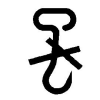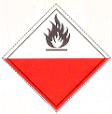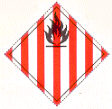| Sisal hemp | [German version] |
Table of contents |
|
| General: | ||
| Product information | ||
| Packaging | ||
| Transport | ||
| Container transport | ||
| Cargo securing | ||
Product information
Product name
| German | Sisalhanf |
| English | Sisal hemp |
| French | Fibre de sisal |
| Spanish | Fibra de sisal |
| Scientific | Agave sisalana |
| CN/HS number * | 5304 ff. |
(* EU Combined Nomenclature/Harmonized System)
Product description
Sisal hemp belongs to the category fibers/fibrous materials, which are classified as follows [24]:
Plant hairs:
| Cotton seed-hairs | |
| Kapok tree fruit hairs |
Stalk fibers from dicotyledonous plants (soft fibers):
| Flax, ramie (fine spinnable fibers) | |
| Hemp, jute, kenaf (coarse spinnable fibers) |
Leaf fibers (hard fibers):
| Sisal, Manila hemp, palm fibers (poor spinning characteristics) |
Bast:
| Linden, raffia palm, willow |
Basketwork material:
| Coconut fiber, rattan cane, halfa, piassava, esparto |
Sisal hemp is a 60 – 100 cm long fiber from the sword-shaped leaves (leaf fiber) of the approximately 2 m tall sisal agave (Agave sisalana), a member of the lily family (Liliaceae).
The sisal plant comes from the native Mexican henequen plant, for which reason Mexican sisal used to be called henequen. These days, it is the generally large East African plantations which are of particular commercial importance.
Like Manila hemp, sisal hemp is a hard fiber. The fibers are white to yellowish-white in color, resistant, supple and light-weight. Sisal hemp is only slightly inferior in quality to Manila hemp.
The fibers are obtained from the fresh leaves by decorticators, washed and dried in the sun. Decorticators are fully automatic machines, to which the sisal leaves are fed cross-ways on a conveyor belt. They remove the leaf tissue by crushing, scraping and washing. If this procedure is not performed carefully, the fibers become blotchy.
The leaf cross-section reveals that the leaves are protected by a wax layer (cuticle) (55% cutin, 20% wax) and the fiber strands are distributed throughout the spongy parenchyma (see Figure 4).
Quality / Duration of storage
Wet, moist or oil-stained bales must be rejected prior to loading because depreciation due to discoloration, mildew and corrosion under the metal straps may occur during transport. A moisture measurement must therefore be carried out on acceptance of a consignment.
Hemp is normally of a whitish to yellowish color. Excessively moist hemp discolors to black. Dark spots arising as a result of moisture may be confused with spots resulting from improper drying of the sisal fibers („sunburn“) (precarriage damage).
Subject to compliance with the appropriate temperature and humidity/moisture conditions, duration of storage is not a limiting factor as regards transport and storage life.
Intended use
Due to its good resistance to moisture, sisal hemp is mainly used to produce cordage (ropes, binder twine etc.), brushes, sailcloth, tarpaulins, awnings, sacks and coarse woven fabrics. In addition to the long fiber bundles, short ones are also obtained, which are used as upholstery stuffing, raw papermaking material or structural panels.
Figures
(Click on the individual Figures to enlarge them.)
 Figure 1 |
 Figure 2 |
Figure 3 |
Manufacture of sisal hemp in Mexico:
Countries of origin
This Table shows only a selection of the most important countries of origin and should not be thought of as exhaustive.
| Europe | |
| Africa | Angola, Kenya, Madagascar, Mozambique, Tanzania |
| Asia | Indonesia |
| America | Mexico, Haiti, Cuba |
| Australia |
Back to beginning
Packaging
Sisal hemp is arranged lengthwise in bundles, it being essential for the fibers to lie parallel so they don’t break. The bundles are grouped together unpackaged in bales which are for the most part strapped with steel strapping or wire and only very occasionally with ropes (e.g. in Brazil). A piece of sacking is often inserted on one side for identification purposes.
| Marking of packages | ||
 Keep dry |
 Use no hooks |
 Keep away from heat (solar radiation) |
Back to beginning
Transport
Symbols
 Spontaneously combustible, Class 4.2 IMDG Code |
 Fire hazard (Flammable solids), Class 4.1 IMDG Code |
 General cargo |
Means of transport
Ship, truck, railroad
Container transport
Standard containers , subject to compliance with water content of goods, packaging and flooring.
Cargo handling
In damp weather (rain, snow), the cargo must be protected from moisture, since sisal hemp is strongly hygroscopic and readily absorbs moisture. This may lead to discoloration and mildew. In the case of severe exposure to seawater and rain, mold starts to grow inside the bale, while the outer surfaces dry off again. In addition, sisal hemp may swell by absorbing water vapor, resulting in a considerable increase in volume. A high water content is difficult to detect from outside, since the sisal hemp does not feel damp even at a water content of 25 – 30%.
Do not use hooks for cargo handling, since they may lead to sparking when they come into contact with metal objects.
In addition, smoking is absolutely prohibited during cargo handling.
Stowage factor
| 2.55 – 3.68 m3/t [1] |
Stowage space requirements
Cool, dry
Segregation
Fiber rope, thin fiber nets
Cargo securing
The cargo is to be secured in such a way that the bales or strapping are not damaged. Undamaged strapping is essential to maintain compression of the bales during transport. If the strapping is broken, compression is diminished, which at the same time results in an increased supply of oxygen to the inside of the bales. This in turn increases the risk of combustion or feeds a fire which has already started. Bursting or chafing of steel strapping may lead to sparking and external ignition.
Back to beginning
Risk factors and loss prevention
RF Temperature
Sisal hemp requires particular temperature, humidity/moisture and possibly ventilation conditions (SC VI) (storage climate conditions).
Favorable travel temperature range: no lower limit – 25°C
Sisal hemp must be stowed away from heat sources.
Every hold should be equipped with means for measuring temperature. Measurements must be performed and recorded daily.
Back to beginning
RF Humidity/Moisture
Sisal hemp requires particular temperature, humidity/moisture and possibly ventilation conditions (SC VI) (storage climate conditions).
| Designation | Humidity/water content | Source |
| Relative humidity | 55% | [1] |
| Water content | 5 – 12% | [1] |
| Maximum equilibrium moisture content | 55% | [1] |
Sisal hemp behaves strongly hygroscopically (hygroscopicity). It must be protected from sea, rain and condensation water and also from high levels of relative humidity, as there is a risk of discoloration and mildew. In the case of severe exposure to seawater and rain, mold starts to grow inside the bale, while the outer surfaces dry off again.
In addition, sisal hemp may swell by absorbing water vapor, resulting in a considerable increase in volume. A high water content is difficult to detect from outside, since the sisal hemp does not feel damp even at a water content of 25 – 30%.
Dark spots arising as a result of moisture may be confused with spots resulting from improper drying of the sisal fibers („sunburn“) (precarriage damage).
Moisture measurements are recommended prior to loading. Moisture-damaged bales must not be accepted.
Back to beginning
RF Ventilation
Sisal hemp requires particular temperature, humidity/moisture and possibly ventilation conditions (SC VI) (storage climate conditions).
If the product is loaded for shipment in a dry state, it does not have any particular ventilation requirements.
Problems arise if the product, packaging and/or ceiling/flooring are too damp. In this case, the following ventilation measures should be implemented:
air exchange rate: 10 changes/hour (airing)
Since sisal hemp very readily absorbs oxygen, before anybody enters the hold, it must be ventilated and a gas measurement carried out if necessary, since a shortage of oxygen may endanger life.
Back to beginning
RF Biotic activity
Sisal hemp displays 3rd order biotic activity.
It belongs to the class of goods in which respiration processes are suspended, but in which biochemical, microbial and other decomposition processes still proceed.
Back to beginning
RF Gases
Sisal hemp very readily absorbs oxygen. An oxygen shortage may therefore arise in closed holds and containers. Before anybody enters such holds, the holds must be ventilated and a gas measurement carried out where necessary.
The increase in CO2 and CO content indicates a cargo fire. The TLV of the hold air is 0.49 vol.%.
Back to beginning
RF Self-heating / Spontaneous combustion
Sisal hemp has an oil content of 8.7 – 20% (waxes).
Sisal hemp is assigned to Class 4.1 of the IMDG Code (Flammable solids). However, its specific characteristics and negative external influences (see below) may cause it to behave like a substance from Class 4.2 (Substances liable to spontaneous combustion) of the IMDG Code or ADR.
Its high cellulose content makes sisal hemp particularly liable to catch fire through external ignition. Therefore, it must always be protected from sparks, fire, naked lights and lit cigarettes. Smoking is absolutely prohibited. Sparks may arise from bursting or chafing of the steel straps (and also as a result of inadequate cargo securing in the hold or container) and cause a cargo fire. In accordance with the IMDG Code, ventilation openings leading into the hold should be provided with spark-proof wire cloth.
Spontaneous combustion may occur as a result of exposure to moisture, animal and vegetable fats/oils, oil-bearing seeds/fruits, copra and raw wool.
Fire-fighting is best performed using CO2 or foam. When fighting a fire, do not break the steel straps or open the bales, since relieving the compression increases the oxygen supply and makes it impossible to fight the fire effectively.
Water must not be used for fire-fighting, since the swelling capacity of the sisal hemp may cause damage to the hold or container walls.
Back to beginning
RF Odor
| Active behavior | Sisal hemp has a slight, pleasant odor. A conspicuous musty odor indicates moisture damage. |
| Passive behavior | Sisal hemp is sensitive to unpleasant or pungent odors. |
Back to beginning
RF Contamination
| Active behavior | Sisal hemp does not cause contamination |
| Passive behavior | Sisal hemp is sensitive to contamination by dust, dirt, fats/oils and rust as well as oil-containing goods, such as oil-bearing seeds/fruits, copra, raw wool etc., since oil-impregnated fibers promote self-heating/cargo fire. Holds or containers must accordingly be clean and in a thoroughly hygienic condition. Residues from previous cargoes, such as ores, stones, coal, metal filings, fertilizers etc., result in losses. Rust contamination may be caused by rusty steel straps, among other things. Rusty steel strapping causes discoloration of the sisal fibers due to flaked-off rust particles which catch in the sisal fibers and impair the spinning process. |
Back to beginning
RF Mechanical influences
Sisal hemp must be stored and transported in such a way that the fibers do not break. Care must be taken to ensure that mechanical influences do not cause damage to strapping, which increases the risk of fire by relieving the compression of the bales and allowing a greater supply of oxygen.
Back to beginning
RF Toxicity / Hazards to health
Since sisal hemp is highly oxygen-absorbent, a life-threatening shortage of oxygen may arise in the hold or container. Thus, before anybody enters the hold, it must be ventilated and, if necessary, a gas measurement carried out. The TLV for CO2 concentration is 0.49 vol.%.
Back to beginning
RF Shrinkage/Shortage
Unclearly marked bales may result in losses of volume due to incorrect delivery.
Back to beginning
RF Insect infestation / Diseases
Bole rot, caused by Aspergillus niger, is the most significant fungal disease. Infection proceeds through the cut leaf stumps, so making it advisable to cut sisal as far as possible in dry weather.
Back to beginning
























